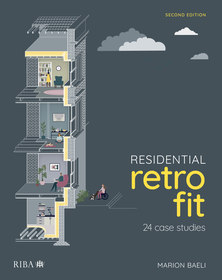
Residential Retrofit
24 Case Studies
-
10% KEDVEZMÉNY?
- A kedvezmény csak az 'Értesítés a kedvenc témákról' hírlevelünk címzettjeinek rendeléseire érvényes.
- Kiadói listaár GBP 40.00
-
19 110 Ft (18 200 Ft + 5% áfa)
Az ár azért becsült, mert a rendelés pillanatában nem lehet pontosan tudni, hogy a beérkezéskor milyen lesz a forint árfolyama az adott termék eredeti devizájához képest. Ha a forint romlana, kissé többet, ha javulna, kissé kevesebbet kell majd fizetnie.
- Kedvezmény(ek) 10% (cc. 1 911 Ft off)
- Kedvezményes ár 17 199 Ft (16 380 Ft + 5% áfa)
Iratkozzon fel most és részesüljön kedvezőbb árainkból!
Feliratkozom
19 110 Ft

Beszerezhetőség
Még nem jelent meg, de rendelhető. A megjelenéstől számított néhány héten belül megérkezik.
Why don't you give exact delivery time?
A beszerzés időigényét az eddigi tapasztalatokra alapozva adjuk meg. Azért becsült, mert a terméket külföldről hozzuk be, így a kiadó kiszolgálásának pillanatnyi gyorsaságától is függ. A megadottnál gyorsabb és lassabb szállítás is elképzelhető, de mindent megteszünk, hogy Ön a lehető leghamarabb jusson hozzá a termékhez.
A termék adatai:
- Kiadás sorszáma 2
- Kiadó RIBA Publishing
- Megjelenés dátuma 2025. november 1.
- ISBN 9781915722577
- Kötéstípus Puhakötés
- Terjedelem160 oldal
- Méret 276x219 mm
- Nyelv angol 700
Kategóriák
Rövid leírás:
The essence of sustainability in buildings is their capability to adapt to change over time. The UK has a large housing stock that has been developed and evolved over generations, and become the fabric and character of our cities, towns and neighbourhoods.
TöbbHosszú leírás:
The essence of sustainability in buildings is their capability to adapt to change over time. The UK has a large housing stock that has been developed and evolved over generations, and become the fabric and character of our cities, towns and neighbourhoods. The capability of buildings to adapt to changing lifestyles is the root of their sustainability. When buildings do not adapt they are disposed of, since it is only active use that confers value. It is only value that provides necessary investment for renewal.
This book presents a series of innovative and best practice case studies of residential low energy retrofit projects, and illustrates what has been achieved in practice in the UK. First published in 2013, this revised edition features additional material and measurements for six of the existing case studies and includes four entirely new case studies.
Offers examples of residential retrofit which can effectively address major issues raised by the UK existing housing stock, such as: major CO2 emissions; energy efficiency; ageing building fabric; uncomfortable internal environments; and fuel poverty.
- Increases the construction industry's understanding of residential retrofits.
- Increases the confidence of professionals and homeowners to undertake low energy retrofits.
- Informs home owners and social landlords of the financial implications and whole life costing of low energy retrofit.
- Illustrates strategies available for different construction types.
- Explains the main issues to look out for in a retrofit project, through the experience of the various case study teams.
- Provides building energy monitoring data to confirm the potential real energy savings.
Tartalomjegyzék:
Foreword Introduction Chapter 1: * UK context (stock profile, energy efficiency per construction type etc.) * UK challenge (Climate change Act, Green deal and energy prices) * UK proposal (Retrofit for the Future) Chapter 2: Case studies on pre-1919 properties (solid masonry) Princedale Road (certified PassivHaus), Bertram Street, Shaftesbury Park Terrace, Hawthorn Road, The Nook, Highfields Leicester, Grove Cottage, Easton Road, Brent, Culford Road, Rectory Grove Chapter 3: Case studies on post 1919-properties. Cwmbach, Byron Square, Lynton, Newport Somerton, Passfield Drive, Stanmore, Penzance, Haddington Way, Coach Road, Blaise Castle Estate, Hensford Gardens, Wilmcote House Chapter 4: Overall view of the projects. Comparison between modelled data and actual data and the new data after 10 years of use Conclusion References & contacts
Több



